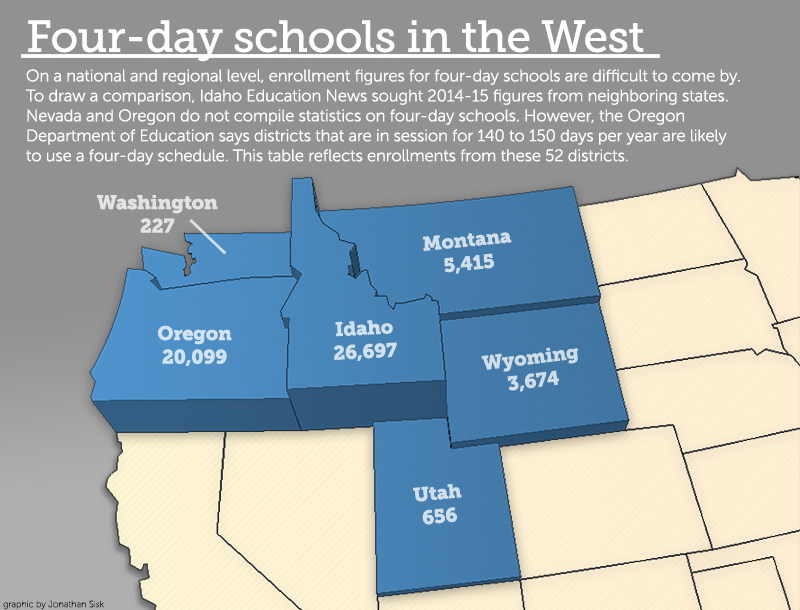What do the numbers say about Idaho’s four-day schools?
Some statistics confirm conventional wisdom. Some statistics contradict political rhetoric. Here’s a look at a few common assertions — and how they stack up against the facts.
Four-day school districts proliferated during the recession: True.

In August 2006, Idaho was in the midst of a real estate boom — and rising property taxes were the issue of the day. Then-Gov. Jim Risch convinced fellow Republicans in the Legislature to slash property taxes used to finance schools. A sales tax increase covered most of the difference, but not all of it.
At the time, however, Idaho’s building boom was nearing its end. It gave way to a global recession that had — and continues to have — a profound effect on Idaho schools.
The effect on the school calendar was especially stark. When schools opened for the 2006-07 year, days after Risch’s tax overhaul became law, only 10 school districts and two charter schools used a four-day schedule. Today, 43 districts and nine charters use a four-day calendar. Many made the move in hopes of saving money.
Four-day education is a rural phenomenon: Mostly true.
Four-day schools are scattered across 29 of Idaho’s 44 counties — and consistent with the national trend, almost all of them can be found in small towns.
Advocates for the four-day calendar say it works best in rural communities. Students’ off days are filled with extracurricular activities and chores, and parents and teachers provide a visible support network. Brad Baumberger recognizes the difference; three years ago, he left Boise’s Borah High School to become superintendent at the Highland School District in Craigmont (2014 population, 503). “I wouldn’t use the four-day week in urban Idaho, at all.”
Yet two Boise charter schools, Sage International School and The Village Charter, use a four-day schedule. The Snake River district and three charter schools operate in Blackfoot, a city of nearly 12,000, about a half hour from Idaho Falls and Pocatello. The North Idaho STEM Charter Academy is based in Rathdrum, a few miles from Coeur d’Alene.
Idaho has more four-day schools than other states: True (at least regionally).
Compared with neighboring states, Idaho has more students, and a higher percentage of students, on a four-day calendar.
Let’s look at one comparison. In Utah, only 656 students attended four-day schools in 2014-15, accounting for .1 percent of the state’s students. Contrast this to Idaho’s numbers: 26,697 students, or 9.2 percent of the student population.
Why is Utah so significant? The rankings vary, depending on methodology, but Utah and Idaho usually rank lowest and second-lowest nationally in per-pupil spending.
It’s hard to tell where Idaho ranks nationally, in terms of four-day schools. In 2013, the National Conference of State Legislatures said 120 districts in 21 states had adopted a four-day schedule. By now, both numbers are outdated, and probably too low.
Four-day schools have struggled to secure local funding: Somewhat true.
The four-day school boom coincided with another recession-era trend. An ever-growing number of districts have been forced to go back to voters to seek supplemental property tax levies — to replace state funding that evaporated as sales tax collections tumbled.
Some districts struggled to pass levies, leaving them particularly vulnerable to state budget cuts. For example, a pair of failed supplemental levies left Owyhee County’s Homedale School District scrambling to find cost-cutting options. School officials adopted a four-day calendar, starting in 2014.
But Homedale is in the minority. Of the 42 school districts on a four-day calendar in 2014-15, 28 had voter-approved supplemental levies on the books. This fall, Hagerman joined the ranks of four-day districts — months after voters said yes to a two-year, $300,000 supplemental levy. (Statewide, 93 of Idaho’s 115 districts have a supplemental levy on the books.)
Four-day schools have higher poverty rates: Somewhat true.
Let’s test this theory by looking at the federal school lunch program — the standard metric for measuring poverty rates.
In 2014-15, 49 percent of all Idaho students qualified for free or reduced-price lunch. Twenty-seven of Idaho’s 42 four-day districts had a higher poverty rate than the state average.
However, several of Idaho’s poorest districts maintain a five-day schedule. This includes the Wilder and Caldwell districts in Canyon County, and the Lapwai and Plummer-Worley districts serving two North Idaho Indian reservations.
Four-day schools are understaffed: Not necessarily true.
The premise here is sensible enough. Four-day schools are trying to cut costs, and staffing is the largest line item in any district’s budget. It would hold, then, that these schools have fewer teachers and larger class sizes.
Four-day districts actually tend to have smaller student-teacher ratios than the state average of 18.9, but the numbers fall all over the map.
Preston, a four-day district in Southeast Idaho, had the highest student-teacher ratio in the state. But four-day districts account for several of the lowest student-teacher ratios in the state. In these small communities, teaching tends to be a labor-intensive enterprise, with a skeleton staff working with a handful of students.
In a community like Mackay, with a student-teacher ratio of 10-to-1, the result is more one-on-one time for students.
“I tell people, Mackay’s almost like a public-private school,” said Michelle Peterson, a fifth-grade and elementary music teacher.
“Rescheduled Education” is the product of a partnership between Idaho Education News and Idaho Public Television. Reporting on the series are Kevin Richert and Clark Corbin of Idaho Education News and Seth Ogilvie and Melissa Davlin of Idaho Public Television. Video producers are Andrew Reed of Idaho Education News and Troy Shreve of Idaho Public Television. Idaho Education News data analyst Randy Schrader compiled data for the series.
‘Rescheduled Education’ at a glance
Day One, Monday, Nov. 16
An unproven experiment, involving 26,881 Idaho students
Data dive: Surprising statistics on four-day schools
Day Two, Tuesday, Nov. 17
Four-day school test scores are inconclusive — but troubling
Sage and COSSA Academy: Two four-day outliers
Day Three, Wednesday, Nov. 18
A schedule change saves money. Just not much.
Preston upholds a decision driven by dollars
Day Four, Thursday, Nov. 19
Teachers and students adjust to longer school days
‘No time to waste:’ Notus runs at a fast pace
Day Five, Tuesday, Nov. 20
Across rural Idaho, four-day weeks become routine
Challis embraces change — but with reservations
Uncomfortable questions, unclear answers on social impacts (Idaho Reports blog)

